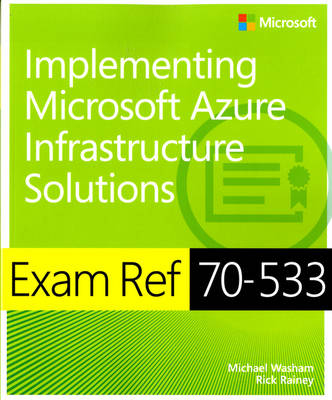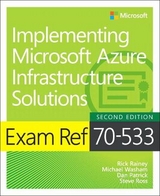
Exam Ref 70-533 Implementing Microsoft Azure Infrastructure Solutions
Microsoft Press,U.S. (Verlag)
978-0-7356-9706-5 (ISBN)
- Titel erscheint in neuer Auflage
- Artikel merken
Focus on the expertise measured by these objectives:
Deploy, configure, monitor, and scale websites
Implement virtual machine workloads, images, disks, networking, and storage
Configure, deploy, manage, and monitor cloud services
Implement blobs, Azure files, SQL databases, and recovery services
Manage access and configure diagnostics, monitoring, and analytics
Implement an Azure Active Directory and integrate apps
Configure and modify virtual networks, including multisite and hybrid networks
This Microsoft Exam Ref:
Organizes its coverage by exam objectives
Features strategic, what-if scenarios to challenge you
Will be valuable for IT pros, including enterprise architects; DevOps, network, server, virtualization, and identity engineers; and storage or security administrators
Assumes you have experience implementing Microsoft Azure infrastructure solutions
Implementing Microsoft Azure Infrastructure Solutions
About the Exam
Exam 70-533 focuses on the skills and knowledge needed to implement web- sites, virtual machines, cloud services, storage, Azure Active Directory, and virtual networks with Microsoft Azure.
About Microsoft Certification
Passing this exam earns you a Microsoft Specialist certification in Microsoft Azure, demonstrating your expertise with the Microsoft Azure enterprise-grade cloud platform.
You can earn this certification by passing Exam 70-532, Developing Microsoft Azure Solutions; or Exam 70-533, Imple- menting Microsoft Azure Infrastructure Solutions; or Exam 70-534, Architecting Microsoft Azure Solutions.
See full details at: microsoft.com/learning
Michael Washam is a Microsoft MVP specializing in Microsoft Azure and is the founder and CEO of Opsgility (www.opsgility.com), a leader in instructor-led and on-demand training for Microsoft Azure and enterprise computing. Prior to starting Opsgility, Michael was a fifteen year Microsoft veteran, and while at Microsoft, Michael's roles included being a Senior Program Manager on the Microsoft Azure Runtime team and a Senior Technical Evangelist for Microsoft Azure Infrastructure Services. Michael was the original developer of the Microsoft Azure PowerShell cmdlets and is a globally recognized speaker for conferences such as TechEd and BUILD. When not focused on cloud computing Michael spends time with his wife and kids in the north Texas area. Rick Rainey is a Microsoft Azure Insider and Advisor, Certified Trainer (MCT), blogger (http://rickrainey.com) and an Azure community enthusiast. At Microsoft, he worked closely with Microsoft Premier Enterprise customers, Independent Software Vendors, and Microsoft Engineering to design and develop applications for the Microsoft Azure platform. Today, he is the owner and CEO of CloudAlloc (http://www.cloudalloc.com), a provider of services and tools designed to achieve maximum business value from applications and infrastructure workloads running in the cloud.
Introduction xv
Microsoft certifications xv
Acknowledgments xvi
Free ebooks from Microsoft Press xvi
Microsoft Virtual Academy xvii
Errata, updates, & book support xvii
We want to hear from you xvii
Stay in touch xvii
Preparing for the exam xix
Chapter 1: Implement Websites 1
Objective 1.1: Deploy Websites 1
Creating an Azure website 2
Defining deployment slots 4
Swapping deployment slots 6
Publishing an Azure website 7
Deploying WebJobs 7
Objective summary 9
Objective review 9
Objective 1.2: Configure websites 10
Configuring site settings 11
Configuring a custom domain for a website 14
Configuring SSL certificates for an Azure website 16
Configuring Azure Traffic Manager 18
Configuring handler mappings 22
Configuring handler mappings using Azure PowerShell 23
Configuring virtual applications and directories 23
Using the Azure Cross-Platform Command-Line Interface tools for configuration tasks 24
Objective summary 26
Objective review 27
Objective 1.3: Configure diagnostics, monitoring, and analytics 28
Enabling application and site diagnostics 28
Retrieving diagnostic logs 30
Viewing streaming logs 32
Monitoring website resources 34
Configuring endpoint monitoring and alerts 36
Configuring alerts based on metrics and events 37
Monitoring Azure services 38
Configuring analytics 39
Configuring backup 40
Objective summary 42
Objective review 43
Objective 1.4: Configure scale and resilience 44
Configuring Autoscale using schedules 44
Configuring Autoscale using metrics 46
Scaling up a website instance 47
Objective summary 48
Objective review 48
Objective 1.5: Manage hosting plans 48
Creating a new web hosting plan 49
Creating a website within an existing web hosting plan 50
Migrating websites between hosting plans 50
Objective summary 51
Objective review 52
Answers 53
Objective 1.1: Thought experiment 53
Objective 1.1: Review 53
Objective 1.2: Thought experiment 54
Objective 1.2: Review 55
Objective 1.3: Thought experiment 56
Objective 1.3: Review 56
Objective 1.4: Thought experiment 57
Objective 1.4: Review 58
Objective 1.5: Thought experiment 58
Objective 1.5: Review 58
Chapter 2: Implement virtual machines 61
Objective 2.1: Deploy workloads on Azure virtual machines (VMs) 61
Identifying supported workloads 62
Creating virtual machines 62
Managing the lifecycle of a virtual machine 80
Connecting to virtual machines 82
Objective summary 86
Objective review 86
Objective 2.2: Implement images and disks 87
Uploading and downloading virtual hard disks 88
Copying virtual hard disks between storage accounts and
subscriptions 89
Virtual machine images 89
Creating images and disks from a virtual hard disk 92
Managing data disks 96
Deleting images and disks 98
Objective summary 99
Objective review 100
Objective 2.3: Perform configuration management 100
Using the custom script extension 101
Implementing Windows PowerShell Desired State Configuration 103
Using the Virtual Machine Access Extension 109
Enabling the Puppet virtual machine extension 110
Enabling the Chef virtual machine extension 111
Extensions without cmdlets 111
Objective summary 112
Objective review 113
Objective 2.4: Configure VM networking 114
Understanding cloud services 114
Configuring endpoints 115
Configuring access control lists 119
Configuring reserved IP addresses 120
Configuring public IP addresses 121
Objective summary 122
Objective review 123
Objective 2.5: Configure VM for resiliency 124
Configuring availability sets 124
Scaling a virtual machine up and down 125
Implementing Autoscale 126
Objective summary 129
Objective review 129
Objective 2.6: Design and implement VM storage 130
Configuring virtual machine disk caching 130
Planning for storage capacity 131
Implementing disk redundancy for durability 131
Implementing disk redundancy for performance 132
Implementing Azure Files 133
Encrypting disks 134
Objective summary 134
Objective review 135
Objective 2.7: Monitor VMs 136
Configuring metrics and alerts 136
Configuring endpoint monitoring 138
Configuring diagnostics 138
Objective summary 140
Objective review 140
Answers 142
Objective 2.1: Thought experiment 142
Objective 2.1: Review 142
Objective 2.2: Thought experiment 143
Objective 2.2: Review 143
Objective 2.3: Thought experiment 144
Objective 2.3: Review 144
Objective 2.4: Thought experiment 145
Objective 2.4: Review 145
Objective 2.5: Thought experiment 146
Objective 2.5: Review 146
Objective 2.6: Thought experiment 147
Objective 2.6: Review 147
Objective 2.7: Thought experiment 148
Objective 2.7: Review 148
Chapter 3: Implement Cloud Services 151
Objective 3.1: Configure Cloud Services and roles 151
Configuring role instance count 152
Configuring role operating system settings 155
Configuring In-Role Cache for Microsoft Azure Cache 157
Configuring a custom domain 160
Configuring SSL 162
Configuring a reserved IP address 164
Configuring network traffic rules 166
Restricting web role access 168
Configuring local storage 170
Configuring role instance size 172
Configuring multiple websites on a web role 173
Configuring remote desktop 176
Objective summary 177
Objective review 178
Objective 3.2: Deploy and manage Cloud Services 180
Packaging a cloud service 180
Deploying a cloud service 182
Perform a virtual IP swap 187
Updating a cloud service deployment 187
Scaling a cloud service 189
Creating a Service Bus namespace 193
Objective summary 195
Objective review 195
Objective 3.3: Monitor Cloud Services 196
Monitoring a cloud service 196
Configuring endpoint monitoring 199
Monitoring a Service Bus queue 200
Monitoring a Service Bus topic 201
Monitoring a Service Bus relay 202
Monitoring a Notification Hub 202
Collecting diagnostics data 203
Objective summary 205
Objective review 205
Answers 206
Objective 3.1: Thought experiment 206
Objective 3.1: Review 206
Objective 3.2: Thought experiment 209
Objective 3.2: Review 209
Objective 3.3: Thought experiment 210
Objective 3.3: Review 210
Chapter 4: Implement storage 213
Objective 4.1: Implement blobs and Azure files 213
Managing blob storage 214
Understanding storage account replication options 216
Using the async blob copy service 218
Configuring, and using, Azure files 220
Using the Import and Export service 221
Implementing Content Delivery Network 223
Configuring custom domains 226
Objective summary 228
Objective review 228
Objective 4.2: Manage access 229
Managing storage account keys 230
Creating, and using, shared access signatures 231
Using a stored access policy 232
Objective summary 233
Objective review 233
Objective 4.3: Configure diagnostics, monitoring, and analytics 234
Configuring Azure Storage Diagnostics 235
Analyzing diagnostic data 236
Enabling monitoring and alerts 238
Objective summary 240
Objective review 240
Objective 4.4: Implement SQL databases 241
Choosing a service tier 241
Implementing point-in-time recovery 243
Implementing geo-replication 245
Scalability strategies 249
Importing and exporting data 252
Objective summary 254
Objective review 255
Objective 4.5: Implement recovery services 255
Protecting servers with Azure Backup 256
Objective summary 262
Objective review 262
Answers 263
Objective 4.2: Thought experiment 263
Objective 4.2: Review 263
Objective 4.3: Thought experiment 264
Objective 4.3: Review 264
Objective 4.4: Thought experiment 265
Objective 4.4: Review 265
Objective 4.5: Thought experiment 266
Objective 4.5: Review 266
Chapter 5: Implement an Azure Active Directory 267
Objective 5.1: Integrate an Azure AD with existing directories 267
Implementing directory synchronization 268
Integrating Azure Active Directory with Office 365 274
Configuring a custom domain 278
Monitoring Azure Active Directory 280
Objective summary 286
Objective review 287
Objective 5.2: Configure the Application Access Panel 288
Adding SaaS applications to Azure Active Directory 289
Configuring access to SaaS applications 289
Customizing the Access Panel and sign-in page 293
Configuring Multi-Factor Authentication 294
Federating with Facebook and Google ID 298
Objective summary 299
Objective review 300
Objective 5.3: Integrate an app with Azure AD 301
Add a web application or web service 301
Adding a native application 307
Configuring graph API permissions for an application 309
Objective summary 311
Objective review 311
Answers 313
Objective 5.1: Thought experiment 313
Objective 5.1: Review 313
Objective 5.2: Thought experiment 315
Objective 5.2: Review 315
Objective 5.3: Thought experiment 316
Objective 5.3: Review 317
Chapter 6: Implement virtual networks 319
Objective 6.1: Configure a virtual network 319
Creating and configuring a virtual network 320
Deploying a virtual machine into a virtual network 324
Deploying a cloud service into a virtual network 326
Configuring internal load balancing 327
Objective summary 329
Objective review 329
Objective 6.2: Modify a network configuration 330
Importing and exporting network configuration settings 330
Changing an existing network configuration 332
Objective summary 334
Objective review 334
Objective 6.3: Design and implement a multi-site or hybrid network 335
Identifying the appropriate connectivity solution 335
Implementing a point-to-site VPN 337
Implementing a site-to-site VPN 340
Implementing a virtual network-to-virtual network VPN 342
Objective summary 350
Objective review 351
Answers 352
Objective 6.1: Thought experiment 352
Objective 6.1: Review 352
Objective 6.2: Thought experiment 353
Objective 6.2: Review 353
Objective 6.3: Thought experiment 354
Objective 6.3: Review 354
| Erscheint lt. Verlag | 19.3.2015 |
|---|---|
| Verlagsort | Redmond |
| Sprache | englisch |
| Maße | 190 x 228 mm |
| Gewicht | 646 g |
| Themenwelt | Informatik ► Betriebssysteme / Server ► Windows |
| Informatik ► Weitere Themen ► Hardware | |
| Informatik ► Weitere Themen ► Zertifizierung | |
| ISBN-10 | 0-7356-9706-X / 073569706X |
| ISBN-13 | 978-0-7356-9706-5 / 9780735697065 |
| Zustand | Neuware |
| Haben Sie eine Frage zum Produkt? |
aus dem Bereich



